EDU101: Analysis of Learning Theories, Principles and Models
VerifiedAdded on 2021/01/01
|22
|6364
|53
Report
AI Summary
This report delves into the core theories, principles, and models integral to education and training. It commences by analyzing learning theories such as competency-based models, constructivism, and behaviorism, alongside the practical application of these theories in teaching through individualized learning plans and competency-based programs. The report then explores diverse learning preference models, including the Honey and Mumford model, VARK model, and Kolb's learning styles, and elucidates how these preferences facilitate inclusive teaching. Further sections examine models of communication, theories of assessment, and curriculum theories, highlighting their practical application in learning environments. The report also analyzes theories and models of reflection and evaluation, emphasizing their significance in reviewing and improving educational practices. Practical examples and case studies are incorporated throughout the report to provide a comprehensive understanding of the topics discussed.
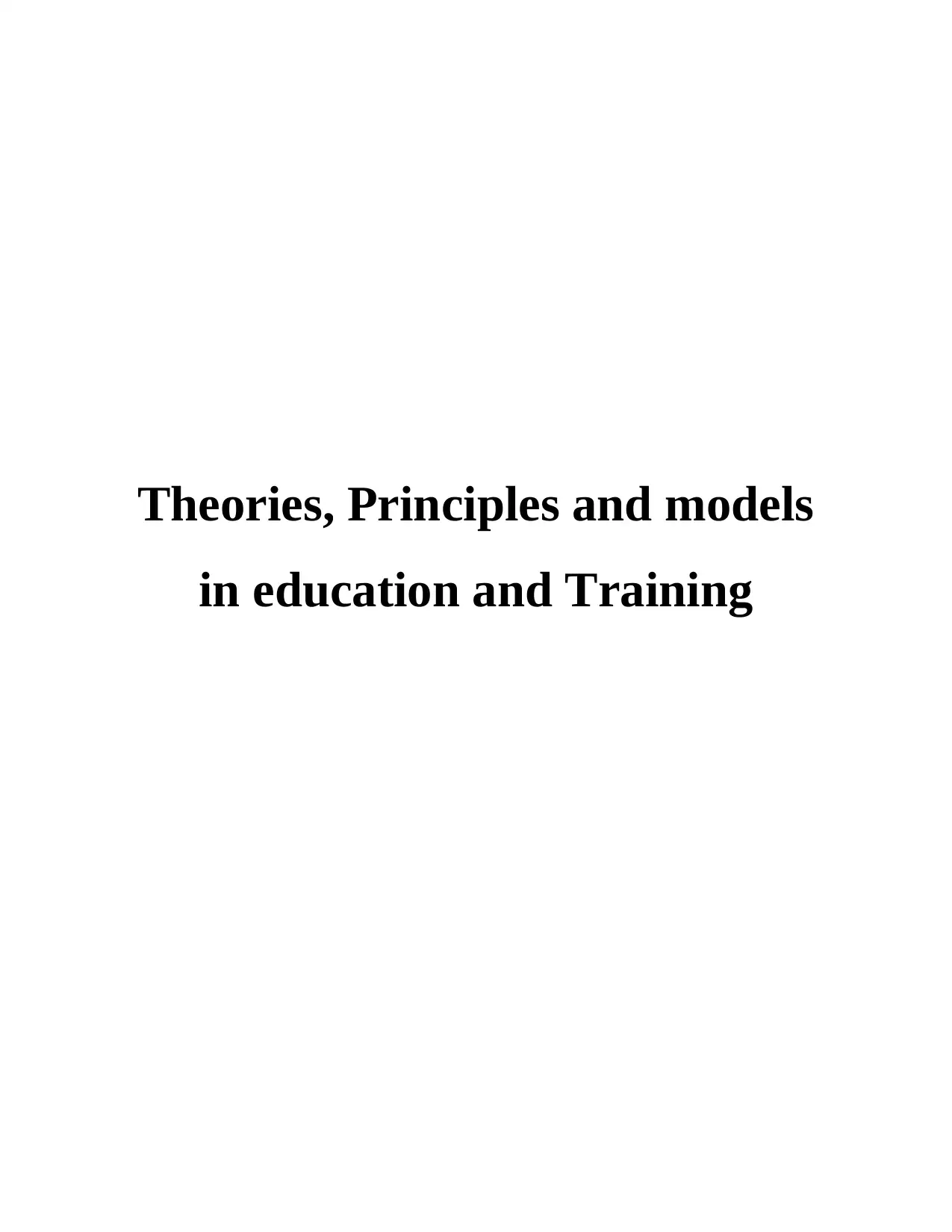
Theories, Principles and models
in education and Training
in education and Training
Paraphrase This Document
Need a fresh take? Get an instant paraphrase of this document with our AI Paraphraser
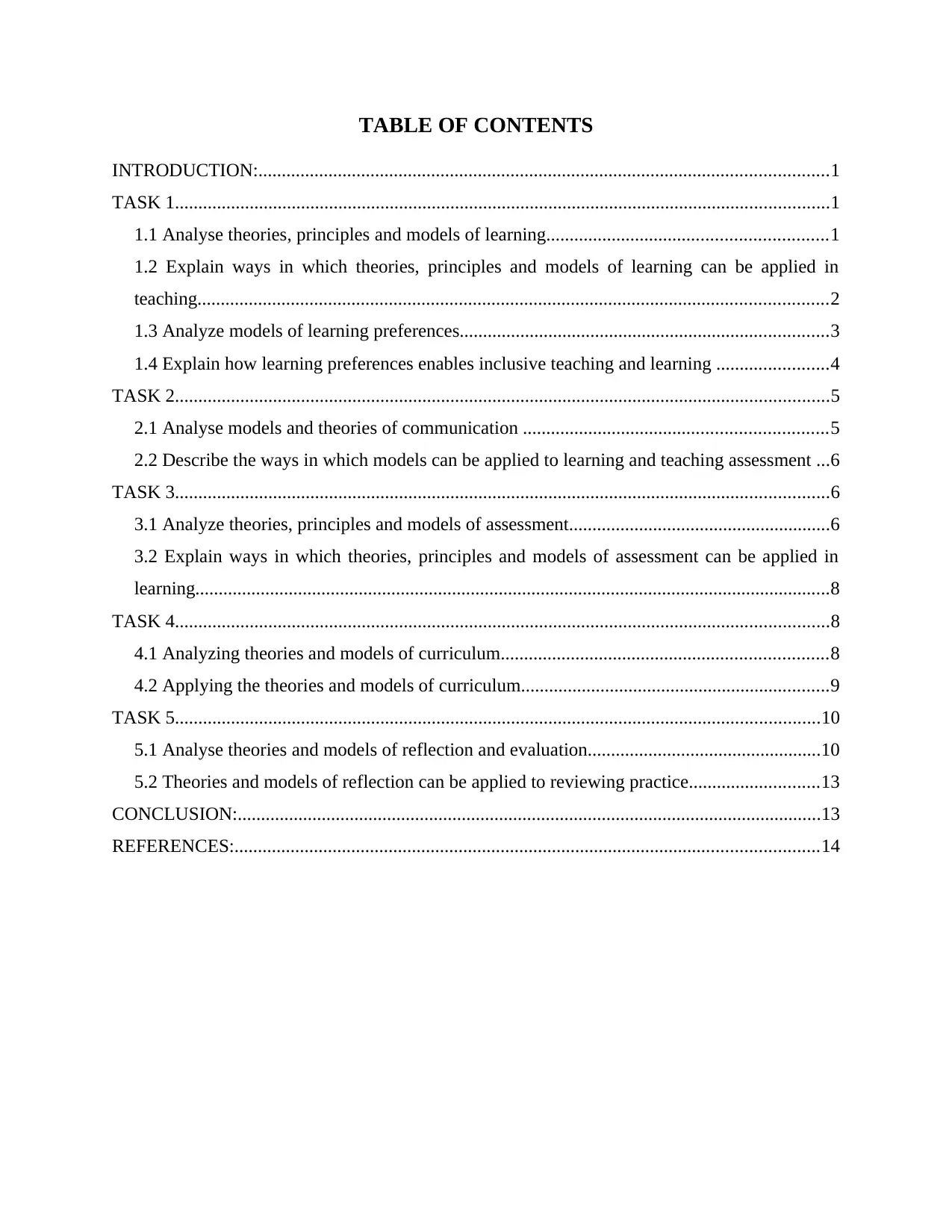
TABLE OF CONTENTS
INTRODUCTION:..........................................................................................................................1
TASK 1............................................................................................................................................1
1.1 Analyse theories, principles and models of learning............................................................1
1.2 Explain ways in which theories, principles and models of learning can be applied in
teaching.......................................................................................................................................2
1.3 Analyze models of learning preferences...............................................................................3
1.4 Explain how learning preferences enables inclusive teaching and learning ........................4
TASK 2............................................................................................................................................5
2.1 Analyse models and theories of communication .................................................................5
2.2 Describe the ways in which models can be applied to learning and teaching assessment ...6
TASK 3............................................................................................................................................6
3.1 Analyze theories, principles and models of assessment........................................................6
3.2 Explain ways in which theories, principles and models of assessment can be applied in
learning........................................................................................................................................8
TASK 4............................................................................................................................................8
4.1 Analyzing theories and models of curriculum......................................................................8
4.2 Applying the theories and models of curriculum..................................................................9
TASK 5..........................................................................................................................................10
5.1 Analyse theories and models of reflection and evaluation..................................................10
5.2 Theories and models of reflection can be applied to reviewing practice............................13
CONCLUSION:.............................................................................................................................13
REFERENCES:.............................................................................................................................14
INTRODUCTION:..........................................................................................................................1
TASK 1............................................................................................................................................1
1.1 Analyse theories, principles and models of learning............................................................1
1.2 Explain ways in which theories, principles and models of learning can be applied in
teaching.......................................................................................................................................2
1.3 Analyze models of learning preferences...............................................................................3
1.4 Explain how learning preferences enables inclusive teaching and learning ........................4
TASK 2............................................................................................................................................5
2.1 Analyse models and theories of communication .................................................................5
2.2 Describe the ways in which models can be applied to learning and teaching assessment ...6
TASK 3............................................................................................................................................6
3.1 Analyze theories, principles and models of assessment........................................................6
3.2 Explain ways in which theories, principles and models of assessment can be applied in
learning........................................................................................................................................8
TASK 4............................................................................................................................................8
4.1 Analyzing theories and models of curriculum......................................................................8
4.2 Applying the theories and models of curriculum..................................................................9
TASK 5..........................................................................................................................................10
5.1 Analyse theories and models of reflection and evaluation..................................................10
5.2 Theories and models of reflection can be applied to reviewing practice............................13
CONCLUSION:.............................................................................................................................13
REFERENCES:.............................................................................................................................14
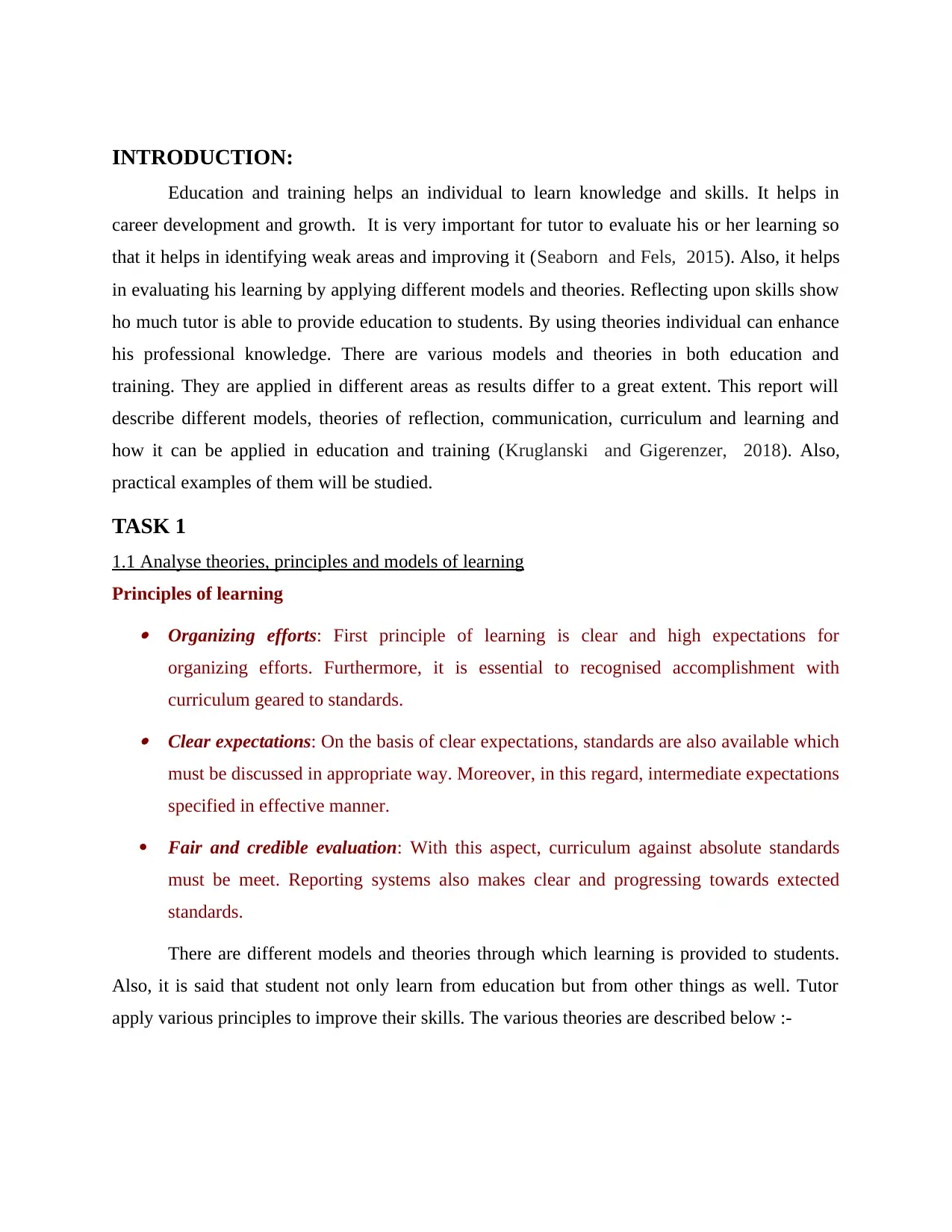
INTRODUCTION:
Education and training helps an individual to learn knowledge and skills. It helps in
career development and growth. It is very important for tutor to evaluate his or her learning so
that it helps in identifying weak areas and improving it (Seaborn and Fels, 2015). Also, it helps
in evaluating his learning by applying different models and theories. Reflecting upon skills show
ho much tutor is able to provide education to students. By using theories individual can enhance
his professional knowledge. There are various models and theories in both education and
training. They are applied in different areas as results differ to a great extent. This report will
describe different models, theories of reflection, communication, curriculum and learning and
how it can be applied in education and training (Kruglanski and Gigerenzer, 2018). Also,
practical examples of them will be studied.
TASK 1
1.1 Analyse theories, principles and models of learning
Principles of learning Organizing efforts: First principle of learning is clear and high expectations for
organizing efforts. Furthermore, it is essential to recognised accomplishment with
curriculum geared to standards. Clear expectations: On the basis of clear expectations, standards are also available which
must be discussed in appropriate way. Moreover, in this regard, intermediate expectations
specified in effective manner.
Fair and credible evaluation: With this aspect, curriculum against absolute standards
must be meet. Reporting systems also makes clear and progressing towards extected
standards.
There are different models and theories through which learning is provided to students.
Also, it is said that student not only learn from education but from other things as well. Tutor
apply various principles to improve their skills. The various theories are described below :-
Education and training helps an individual to learn knowledge and skills. It helps in
career development and growth. It is very important for tutor to evaluate his or her learning so
that it helps in identifying weak areas and improving it (Seaborn and Fels, 2015). Also, it helps
in evaluating his learning by applying different models and theories. Reflecting upon skills show
ho much tutor is able to provide education to students. By using theories individual can enhance
his professional knowledge. There are various models and theories in both education and
training. They are applied in different areas as results differ to a great extent. This report will
describe different models, theories of reflection, communication, curriculum and learning and
how it can be applied in education and training (Kruglanski and Gigerenzer, 2018). Also,
practical examples of them will be studied.
TASK 1
1.1 Analyse theories, principles and models of learning
Principles of learning Organizing efforts: First principle of learning is clear and high expectations for
organizing efforts. Furthermore, it is essential to recognised accomplishment with
curriculum geared to standards. Clear expectations: On the basis of clear expectations, standards are also available which
must be discussed in appropriate way. Moreover, in this regard, intermediate expectations
specified in effective manner.
Fair and credible evaluation: With this aspect, curriculum against absolute standards
must be meet. Reporting systems also makes clear and progressing towards extected
standards.
There are different models and theories through which learning is provided to students.
Also, it is said that student not only learn from education but from other things as well. Tutor
apply various principles to improve their skills. The various theories are described below :-
⊘ This is a preview!⊘
Do you want full access?
Subscribe today to unlock all pages.

Trusted by 1+ million students worldwide
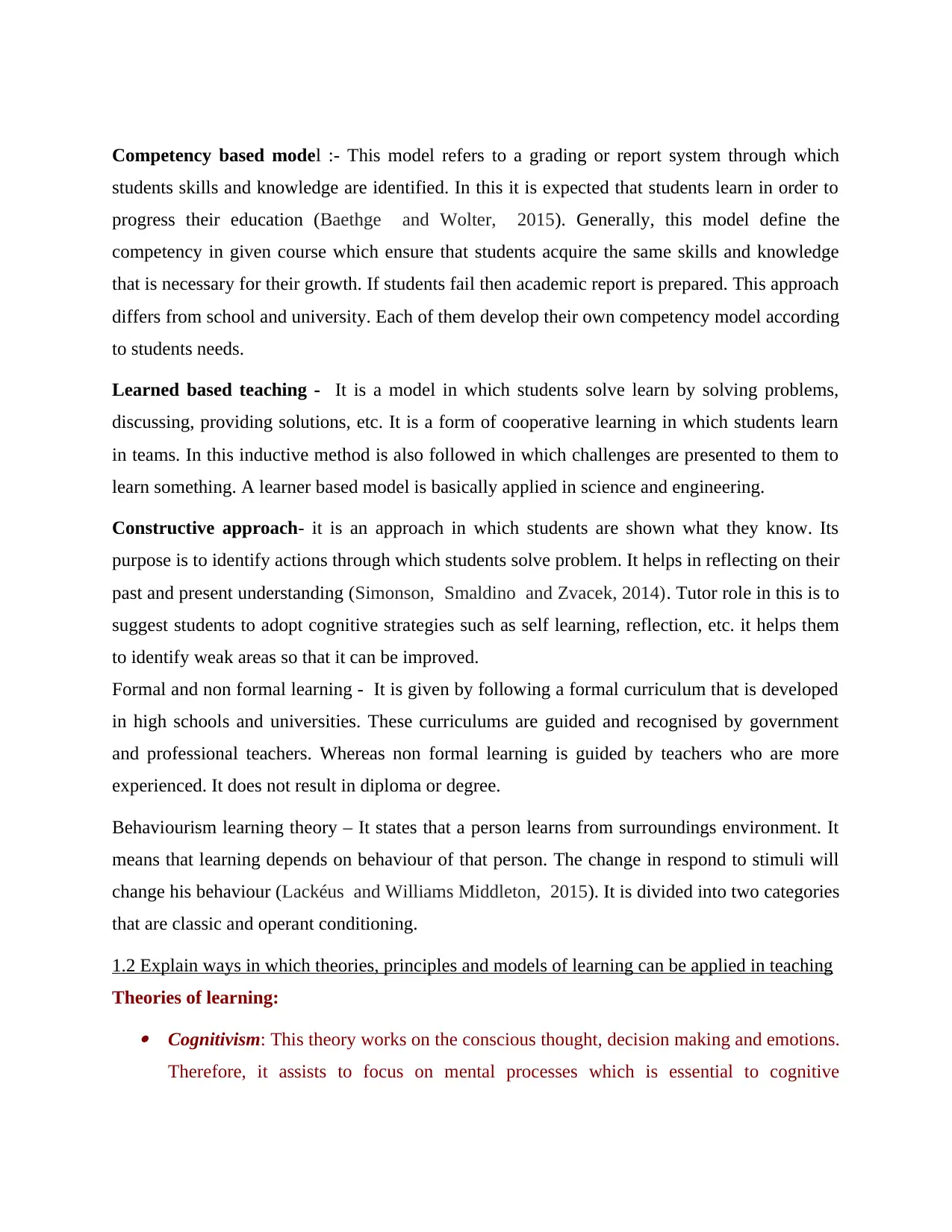
Competency based model :- This model refers to a grading or report system through which
students skills and knowledge are identified. In this it is expected that students learn in order to
progress their education (Baethge and Wolter, 2015). Generally, this model define the
competency in given course which ensure that students acquire the same skills and knowledge
that is necessary for their growth. If students fail then academic report is prepared. This approach
differs from school and university. Each of them develop their own competency model according
to students needs.
Learned based teaching - It is a model in which students solve learn by solving problems,
discussing, providing solutions, etc. It is a form of cooperative learning in which students learn
in teams. In this inductive method is also followed in which challenges are presented to them to
learn something. A learner based model is basically applied in science and engineering.
Constructive approach- it is an approach in which students are shown what they know. Its
purpose is to identify actions through which students solve problem. It helps in reflecting on their
past and present understanding (Simonson, Smaldino and Zvacek, 2014). Tutor role in this is to
suggest students to adopt cognitive strategies such as self learning, reflection, etc. it helps them
to identify weak areas so that it can be improved.
Formal and non formal learning - It is given by following a formal curriculum that is developed
in high schools and universities. These curriculums are guided and recognised by government
and professional teachers. Whereas non formal learning is guided by teachers who are more
experienced. It does not result in diploma or degree.
Behaviourism learning theory – It states that a person learns from surroundings environment. It
means that learning depends on behaviour of that person. The change in respond to stimuli will
change his behaviour (Lackéus and Williams Middleton, 2015). It is divided into two categories
that are classic and operant conditioning.
1.2 Explain ways in which theories, principles and models of learning can be applied in teaching
Theories of learning: Cognitivism: This theory works on the conscious thought, decision making and emotions.
Therefore, it assists to focus on mental processes which is essential to cognitive
students skills and knowledge are identified. In this it is expected that students learn in order to
progress their education (Baethge and Wolter, 2015). Generally, this model define the
competency in given course which ensure that students acquire the same skills and knowledge
that is necessary for their growth. If students fail then academic report is prepared. This approach
differs from school and university. Each of them develop their own competency model according
to students needs.
Learned based teaching - It is a model in which students solve learn by solving problems,
discussing, providing solutions, etc. It is a form of cooperative learning in which students learn
in teams. In this inductive method is also followed in which challenges are presented to them to
learn something. A learner based model is basically applied in science and engineering.
Constructive approach- it is an approach in which students are shown what they know. Its
purpose is to identify actions through which students solve problem. It helps in reflecting on their
past and present understanding (Simonson, Smaldino and Zvacek, 2014). Tutor role in this is to
suggest students to adopt cognitive strategies such as self learning, reflection, etc. it helps them
to identify weak areas so that it can be improved.
Formal and non formal learning - It is given by following a formal curriculum that is developed
in high schools and universities. These curriculums are guided and recognised by government
and professional teachers. Whereas non formal learning is guided by teachers who are more
experienced. It does not result in diploma or degree.
Behaviourism learning theory – It states that a person learns from surroundings environment. It
means that learning depends on behaviour of that person. The change in respond to stimuli will
change his behaviour (Lackéus and Williams Middleton, 2015). It is divided into two categories
that are classic and operant conditioning.
1.2 Explain ways in which theories, principles and models of learning can be applied in teaching
Theories of learning: Cognitivism: This theory works on the conscious thought, decision making and emotions.
Therefore, it assists to focus on mental processes which is essential to cognitive
Paraphrase This Document
Need a fresh take? Get an instant paraphrase of this document with our AI Paraphraser
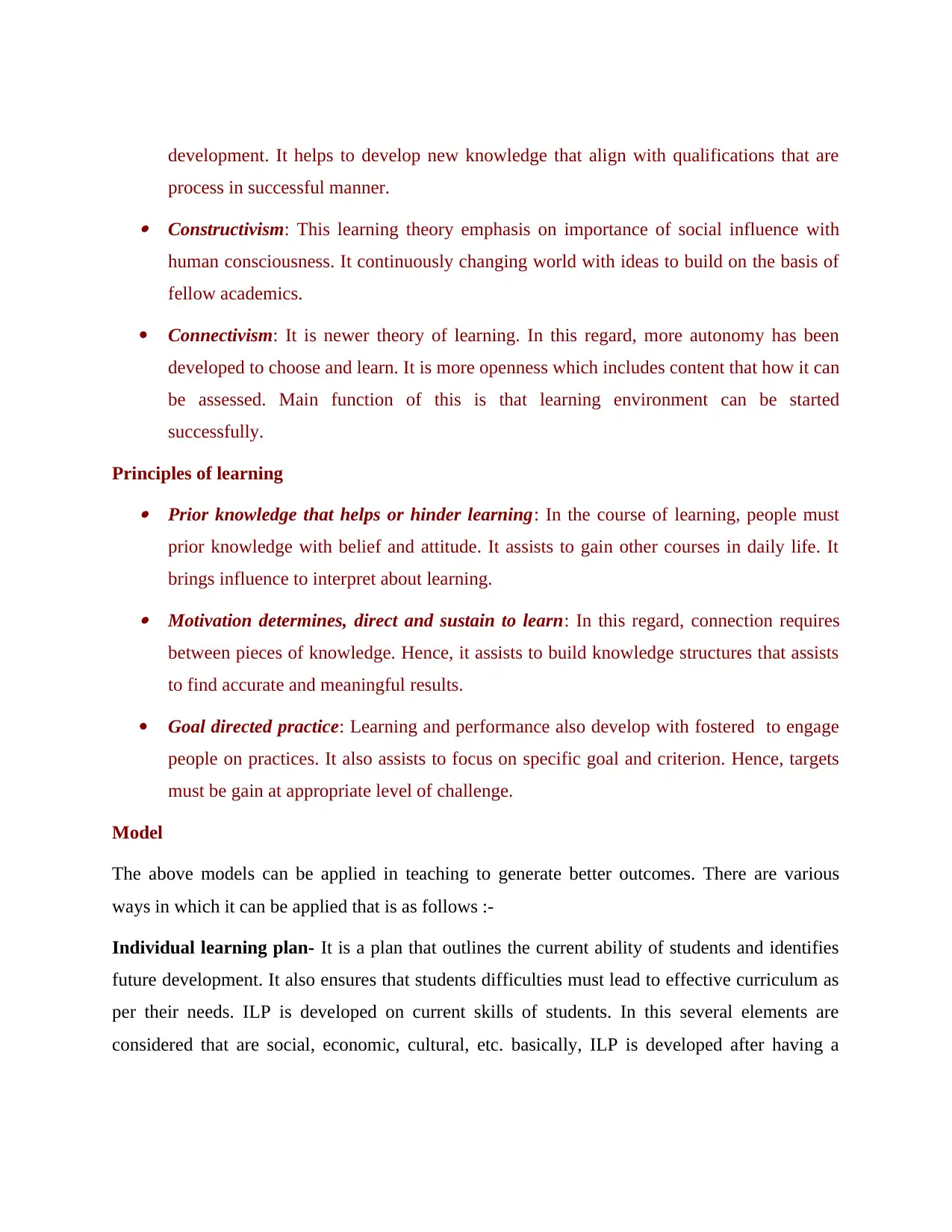
development. It helps to develop new knowledge that align with qualifications that are
process in successful manner. Constructivism: This learning theory emphasis on importance of social influence with
human consciousness. It continuously changing world with ideas to build on the basis of
fellow academics.
Connectivism: It is newer theory of learning. In this regard, more autonomy has been
developed to choose and learn. It is more openness which includes content that how it can
be assessed. Main function of this is that learning environment can be started
successfully.
Principles of learning Prior knowledge that helps or hinder learning: In the course of learning, people must
prior knowledge with belief and attitude. It assists to gain other courses in daily life. It
brings influence to interpret about learning. Motivation determines, direct and sustain to learn: In this regard, connection requires
between pieces of knowledge. Hence, it assists to build knowledge structures that assists
to find accurate and meaningful results.
Goal directed practice: Learning and performance also develop with fostered to engage
people on practices. It also assists to focus on specific goal and criterion. Hence, targets
must be gain at appropriate level of challenge.
Model
The above models can be applied in teaching to generate better outcomes. There are various
ways in which it can be applied that is as follows :-
Individual learning plan- It is a plan that outlines the current ability of students and identifies
future development. It also ensures that students difficulties must lead to effective curriculum as
per their needs. ILP is developed on current skills of students. In this several elements are
considered that are social, economic, cultural, etc. basically, ILP is developed after having a
process in successful manner. Constructivism: This learning theory emphasis on importance of social influence with
human consciousness. It continuously changing world with ideas to build on the basis of
fellow academics.
Connectivism: It is newer theory of learning. In this regard, more autonomy has been
developed to choose and learn. It is more openness which includes content that how it can
be assessed. Main function of this is that learning environment can be started
successfully.
Principles of learning Prior knowledge that helps or hinder learning: In the course of learning, people must
prior knowledge with belief and attitude. It assists to gain other courses in daily life. It
brings influence to interpret about learning. Motivation determines, direct and sustain to learn: In this regard, connection requires
between pieces of knowledge. Hence, it assists to build knowledge structures that assists
to find accurate and meaningful results.
Goal directed practice: Learning and performance also develop with fostered to engage
people on practices. It also assists to focus on specific goal and criterion. Hence, targets
must be gain at appropriate level of challenge.
Model
The above models can be applied in teaching to generate better outcomes. There are various
ways in which it can be applied that is as follows :-
Individual learning plan- It is a plan that outlines the current ability of students and identifies
future development. It also ensures that students difficulties must lead to effective curriculum as
per their needs. ILP is developed on current skills of students. In this several elements are
considered that are social, economic, cultural, etc. basically, ILP is developed after having a
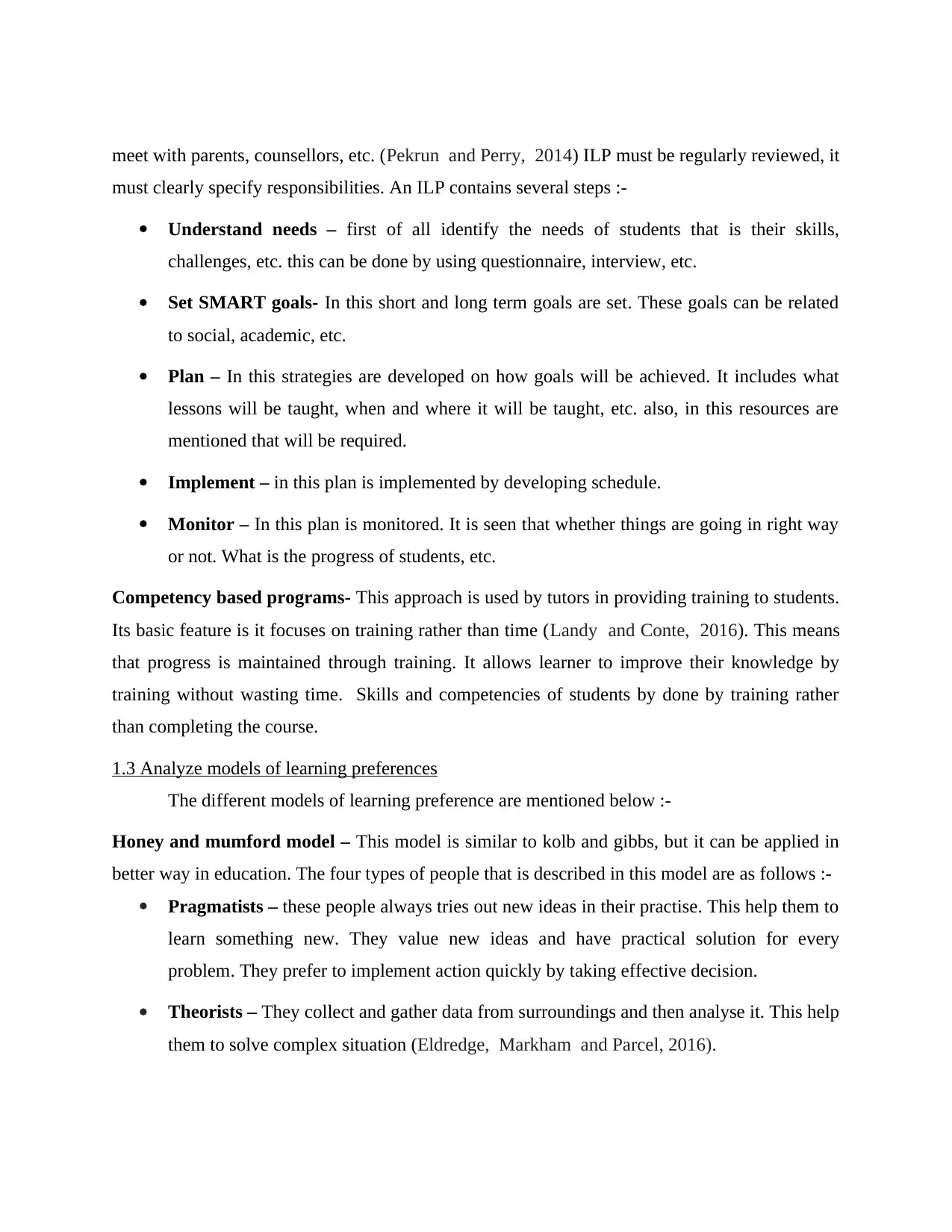
meet with parents, counsellors, etc. (Pekrun and Perry, 2014) ILP must be regularly reviewed, it
must clearly specify responsibilities. An ILP contains several steps :-
Understand needs – first of all identify the needs of students that is their skills,
challenges, etc. this can be done by using questionnaire, interview, etc.
Set SMART goals- In this short and long term goals are set. These goals can be related
to social, academic, etc.
Plan – In this strategies are developed on how goals will be achieved. It includes what
lessons will be taught, when and where it will be taught, etc. also, in this resources are
mentioned that will be required.
Implement – in this plan is implemented by developing schedule.
Monitor – In this plan is monitored. It is seen that whether things are going in right way
or not. What is the progress of students, etc.
Competency based programs- This approach is used by tutors in providing training to students.
Its basic feature is it focuses on training rather than time (Landy and Conte, 2016). This means
that progress is maintained through training. It allows learner to improve their knowledge by
training without wasting time. Skills and competencies of students by done by training rather
than completing the course.
1.3 Analyze models of learning preferences
The different models of learning preference are mentioned below :-
Honey and mumford model – This model is similar to kolb and gibbs, but it can be applied in
better way in education. The four types of people that is described in this model are as follows :-
Pragmatists – these people always tries out new ideas in their practise. This help them to
learn something new. They value new ideas and have practical solution for every
problem. They prefer to implement action quickly by taking effective decision.
Theorists – They collect and gather data from surroundings and then analyse it. This help
them to solve complex situation (Eldredge, Markham and Parcel, 2016).
must clearly specify responsibilities. An ILP contains several steps :-
Understand needs – first of all identify the needs of students that is their skills,
challenges, etc. this can be done by using questionnaire, interview, etc.
Set SMART goals- In this short and long term goals are set. These goals can be related
to social, academic, etc.
Plan – In this strategies are developed on how goals will be achieved. It includes what
lessons will be taught, when and where it will be taught, etc. also, in this resources are
mentioned that will be required.
Implement – in this plan is implemented by developing schedule.
Monitor – In this plan is monitored. It is seen that whether things are going in right way
or not. What is the progress of students, etc.
Competency based programs- This approach is used by tutors in providing training to students.
Its basic feature is it focuses on training rather than time (Landy and Conte, 2016). This means
that progress is maintained through training. It allows learner to improve their knowledge by
training without wasting time. Skills and competencies of students by done by training rather
than completing the course.
1.3 Analyze models of learning preferences
The different models of learning preference are mentioned below :-
Honey and mumford model – This model is similar to kolb and gibbs, but it can be applied in
better way in education. The four types of people that is described in this model are as follows :-
Pragmatists – these people always tries out new ideas in their practise. This help them to
learn something new. They value new ideas and have practical solution for every
problem. They prefer to implement action quickly by taking effective decision.
Theorists – They collect and gather data from surroundings and then analyse it. This help
them to solve complex situation (Eldredge, Markham and Parcel, 2016).
⊘ This is a preview!⊘
Do you want full access?
Subscribe today to unlock all pages.

Trusted by 1+ million students worldwide
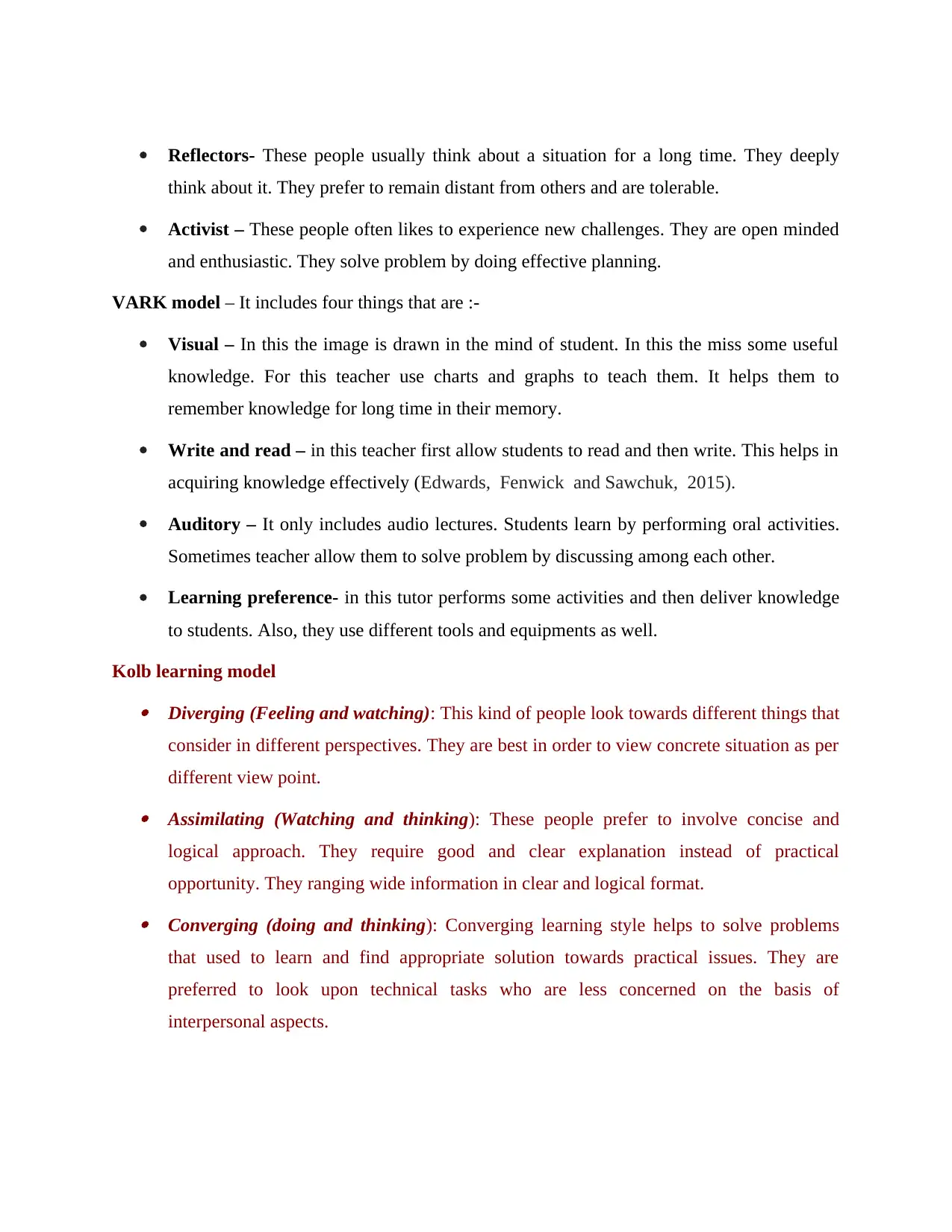
Reflectors- These people usually think about a situation for a long time. They deeply
think about it. They prefer to remain distant from others and are tolerable.
Activist – These people often likes to experience new challenges. They are open minded
and enthusiastic. They solve problem by doing effective planning.
VARK model – It includes four things that are :-
Visual – In this the image is drawn in the mind of student. In this the miss some useful
knowledge. For this teacher use charts and graphs to teach them. It helps them to
remember knowledge for long time in their memory.
Write and read – in this teacher first allow students to read and then write. This helps in
acquiring knowledge effectively (Edwards, Fenwick and Sawchuk, 2015).
Auditory – It only includes audio lectures. Students learn by performing oral activities.
Sometimes teacher allow them to solve problem by discussing among each other.
Learning preference- in this tutor performs some activities and then deliver knowledge
to students. Also, they use different tools and equipments as well.
Kolb learning model Diverging (Feeling and watching): This kind of people look towards different things that
consider in different perspectives. They are best in order to view concrete situation as per
different view point. Assimilating (Watching and thinking): These people prefer to involve concise and
logical approach. They require good and clear explanation instead of practical
opportunity. They ranging wide information in clear and logical format. Converging (doing and thinking): Converging learning style helps to solve problems
that used to learn and find appropriate solution towards practical issues. They are
preferred to look upon technical tasks who are less concerned on the basis of
interpersonal aspects.
think about it. They prefer to remain distant from others and are tolerable.
Activist – These people often likes to experience new challenges. They are open minded
and enthusiastic. They solve problem by doing effective planning.
VARK model – It includes four things that are :-
Visual – In this the image is drawn in the mind of student. In this the miss some useful
knowledge. For this teacher use charts and graphs to teach them. It helps them to
remember knowledge for long time in their memory.
Write and read – in this teacher first allow students to read and then write. This helps in
acquiring knowledge effectively (Edwards, Fenwick and Sawchuk, 2015).
Auditory – It only includes audio lectures. Students learn by performing oral activities.
Sometimes teacher allow them to solve problem by discussing among each other.
Learning preference- in this tutor performs some activities and then deliver knowledge
to students. Also, they use different tools and equipments as well.
Kolb learning model Diverging (Feeling and watching): This kind of people look towards different things that
consider in different perspectives. They are best in order to view concrete situation as per
different view point. Assimilating (Watching and thinking): These people prefer to involve concise and
logical approach. They require good and clear explanation instead of practical
opportunity. They ranging wide information in clear and logical format. Converging (doing and thinking): Converging learning style helps to solve problems
that used to learn and find appropriate solution towards practical issues. They are
preferred to look upon technical tasks who are less concerned on the basis of
interpersonal aspects.
Paraphrase This Document
Need a fresh take? Get an instant paraphrase of this document with our AI Paraphraser
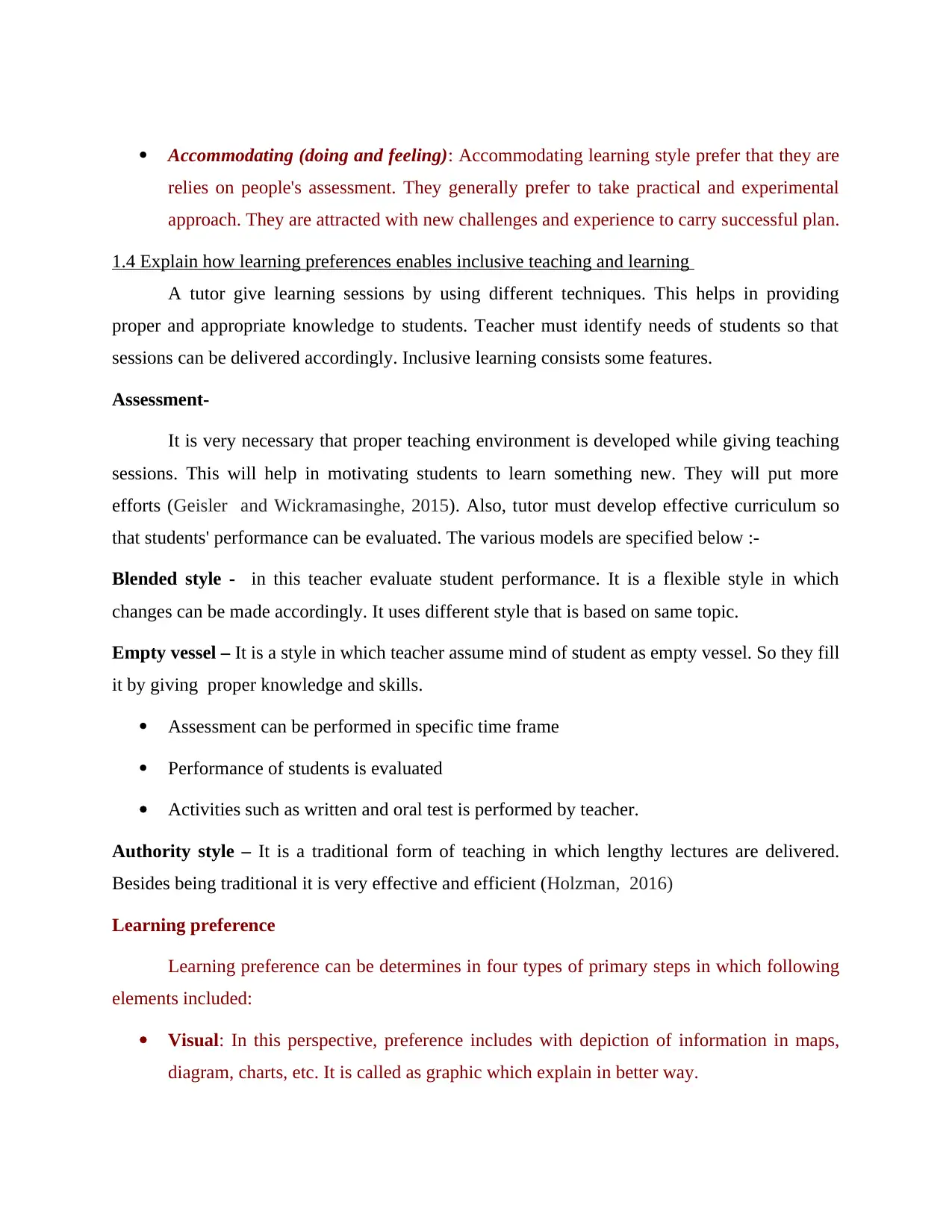
Accommodating (doing and feeling): Accommodating learning style prefer that they are
relies on people's assessment. They generally prefer to take practical and experimental
approach. They are attracted with new challenges and experience to carry successful plan.
1.4 Explain how learning preferences enables inclusive teaching and learning
A tutor give learning sessions by using different techniques. This helps in providing
proper and appropriate knowledge to students. Teacher must identify needs of students so that
sessions can be delivered accordingly. Inclusive learning consists some features.
Assessment-
It is very necessary that proper teaching environment is developed while giving teaching
sessions. This will help in motivating students to learn something new. They will put more
efforts (Geisler and Wickramasinghe, 2015). Also, tutor must develop effective curriculum so
that students' performance can be evaluated. The various models are specified below :-
Blended style - in this teacher evaluate student performance. It is a flexible style in which
changes can be made accordingly. It uses different style that is based on same topic.
Empty vessel – It is a style in which teacher assume mind of student as empty vessel. So they fill
it by giving proper knowledge and skills.
Assessment can be performed in specific time frame
Performance of students is evaluated
Activities such as written and oral test is performed by teacher.
Authority style – It is a traditional form of teaching in which lengthy lectures are delivered.
Besides being traditional it is very effective and efficient (Holzman, 2016)
Learning preference
Learning preference can be determines in four types of primary steps in which following
elements included:
Visual: In this perspective, preference includes with depiction of information in maps,
diagram, charts, etc. It is called as graphic which explain in better way.
relies on people's assessment. They generally prefer to take practical and experimental
approach. They are attracted with new challenges and experience to carry successful plan.
1.4 Explain how learning preferences enables inclusive teaching and learning
A tutor give learning sessions by using different techniques. This helps in providing
proper and appropriate knowledge to students. Teacher must identify needs of students so that
sessions can be delivered accordingly. Inclusive learning consists some features.
Assessment-
It is very necessary that proper teaching environment is developed while giving teaching
sessions. This will help in motivating students to learn something new. They will put more
efforts (Geisler and Wickramasinghe, 2015). Also, tutor must develop effective curriculum so
that students' performance can be evaluated. The various models are specified below :-
Blended style - in this teacher evaluate student performance. It is a flexible style in which
changes can be made accordingly. It uses different style that is based on same topic.
Empty vessel – It is a style in which teacher assume mind of student as empty vessel. So they fill
it by giving proper knowledge and skills.
Assessment can be performed in specific time frame
Performance of students is evaluated
Activities such as written and oral test is performed by teacher.
Authority style – It is a traditional form of teaching in which lengthy lectures are delivered.
Besides being traditional it is very effective and efficient (Holzman, 2016)
Learning preference
Learning preference can be determines in four types of primary steps in which following
elements included:
Visual: In this perspective, preference includes with depiction of information in maps,
diagram, charts, etc. It is called as graphic which explain in better way.
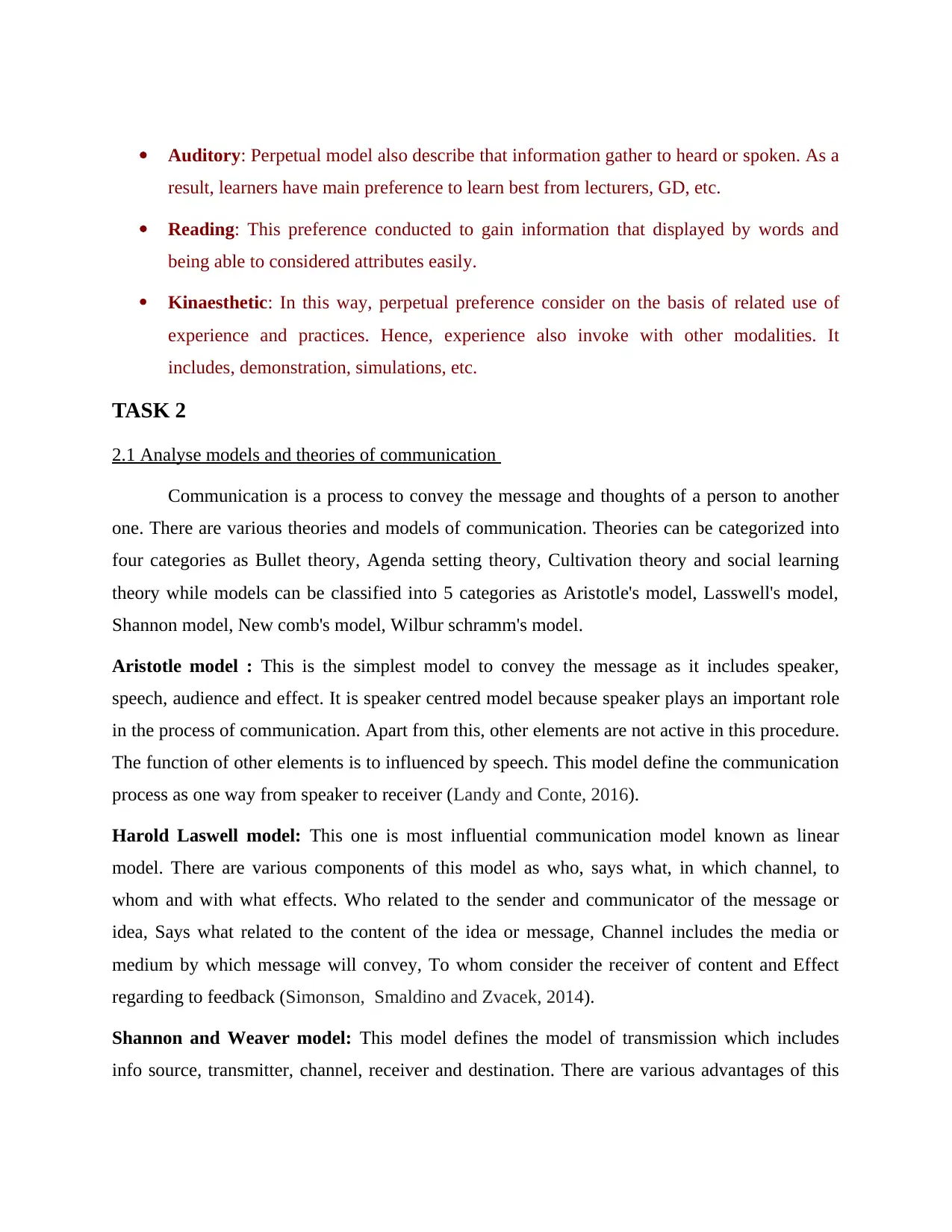
Auditory: Perpetual model also describe that information gather to heard or spoken. As a
result, learners have main preference to learn best from lecturers, GD, etc.
Reading: This preference conducted to gain information that displayed by words and
being able to considered attributes easily.
Kinaesthetic: In this way, perpetual preference consider on the basis of related use of
experience and practices. Hence, experience also invoke with other modalities. It
includes, demonstration, simulations, etc.
TASK 2
2.1 Analyse models and theories of communication
Communication is a process to convey the message and thoughts of a person to another
one. There are various theories and models of communication. Theories can be categorized into
four categories as Bullet theory, Agenda setting theory, Cultivation theory and social learning
theory while models can be classified into 5 categories as Aristotle's model, Lasswell's model,
Shannon model, New comb's model, Wilbur schramm's model.
Aristotle model : This is the simplest model to convey the message as it includes speaker,
speech, audience and effect. It is speaker centred model because speaker plays an important role
in the process of communication. Apart from this, other elements are not active in this procedure.
The function of other elements is to influenced by speech. This model define the communication
process as one way from speaker to receiver (Landy and Conte, 2016).
Harold Laswell model: This one is most influential communication model known as linear
model. There are various components of this model as who, says what, in which channel, to
whom and with what effects. Who related to the sender and communicator of the message or
idea, Says what related to the content of the idea or message, Channel includes the media or
medium by which message will convey, To whom consider the receiver of content and Effect
regarding to feedback (Simonson, Smaldino and Zvacek, 2014).
Shannon and Weaver model: This model defines the model of transmission which includes
info source, transmitter, channel, receiver and destination. There are various advantages of this
result, learners have main preference to learn best from lecturers, GD, etc.
Reading: This preference conducted to gain information that displayed by words and
being able to considered attributes easily.
Kinaesthetic: In this way, perpetual preference consider on the basis of related use of
experience and practices. Hence, experience also invoke with other modalities. It
includes, demonstration, simulations, etc.
TASK 2
2.1 Analyse models and theories of communication
Communication is a process to convey the message and thoughts of a person to another
one. There are various theories and models of communication. Theories can be categorized into
four categories as Bullet theory, Agenda setting theory, Cultivation theory and social learning
theory while models can be classified into 5 categories as Aristotle's model, Lasswell's model,
Shannon model, New comb's model, Wilbur schramm's model.
Aristotle model : This is the simplest model to convey the message as it includes speaker,
speech, audience and effect. It is speaker centred model because speaker plays an important role
in the process of communication. Apart from this, other elements are not active in this procedure.
The function of other elements is to influenced by speech. This model define the communication
process as one way from speaker to receiver (Landy and Conte, 2016).
Harold Laswell model: This one is most influential communication model known as linear
model. There are various components of this model as who, says what, in which channel, to
whom and with what effects. Who related to the sender and communicator of the message or
idea, Says what related to the content of the idea or message, Channel includes the media or
medium by which message will convey, To whom consider the receiver of content and Effect
regarding to feedback (Simonson, Smaldino and Zvacek, 2014).
Shannon and Weaver model: This model defines the model of transmission which includes
info source, transmitter, channel, receiver and destination. There are various advantages of this
⊘ This is a preview!⊘
Do you want full access?
Subscribe today to unlock all pages.

Trusted by 1+ million students worldwide
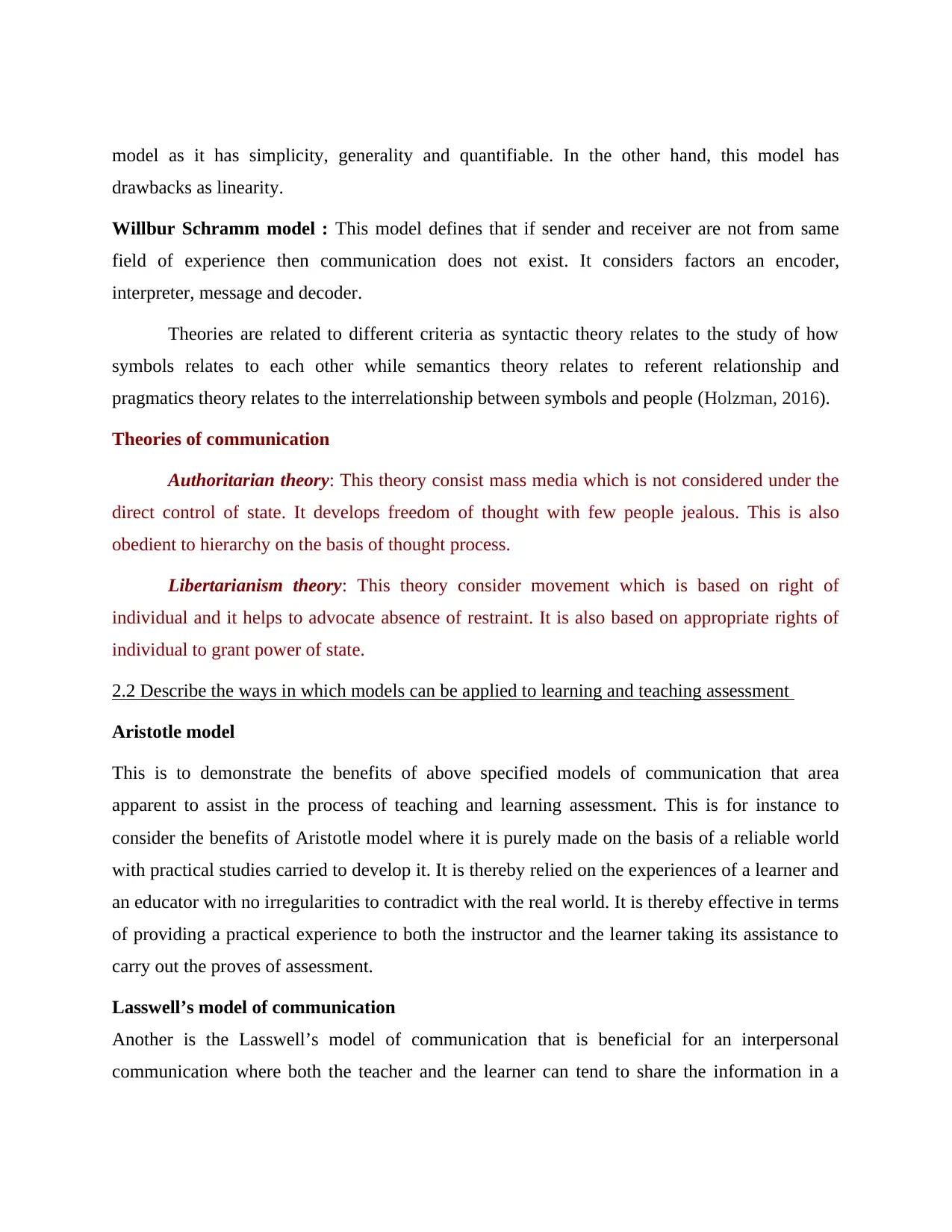
model as it has simplicity, generality and quantifiable. In the other hand, this model has
drawbacks as linearity.
Willbur Schramm model : This model defines that if sender and receiver are not from same
field of experience then communication does not exist. It considers factors an encoder,
interpreter, message and decoder.
Theories are related to different criteria as syntactic theory relates to the study of how
symbols relates to each other while semantics theory relates to referent relationship and
pragmatics theory relates to the interrelationship between symbols and people (Holzman, 2016).
Theories of communication
Authoritarian theory: This theory consist mass media which is not considered under the
direct control of state. It develops freedom of thought with few people jealous. This is also
obedient to hierarchy on the basis of thought process.
Libertarianism theory: This theory consider movement which is based on right of
individual and it helps to advocate absence of restraint. It is also based on appropriate rights of
individual to grant power of state.
2.2 Describe the ways in which models can be applied to learning and teaching assessment
Aristotle model
This is to demonstrate the benefits of above specified models of communication that area
apparent to assist in the process of teaching and learning assessment. This is for instance to
consider the benefits of Aristotle model where it is purely made on the basis of a reliable world
with practical studies carried to develop it. It is thereby relied on the experiences of a learner and
an educator with no irregularities to contradict with the real world. It is thereby effective in terms
of providing a practical experience to both the instructor and the learner taking its assistance to
carry out the proves of assessment.
Lasswell’s model of communication
Another is the Lasswell’s model of communication that is beneficial for an interpersonal
communication where both the teacher and the learner can tend to share the information in a
drawbacks as linearity.
Willbur Schramm model : This model defines that if sender and receiver are not from same
field of experience then communication does not exist. It considers factors an encoder,
interpreter, message and decoder.
Theories are related to different criteria as syntactic theory relates to the study of how
symbols relates to each other while semantics theory relates to referent relationship and
pragmatics theory relates to the interrelationship between symbols and people (Holzman, 2016).
Theories of communication
Authoritarian theory: This theory consist mass media which is not considered under the
direct control of state. It develops freedom of thought with few people jealous. This is also
obedient to hierarchy on the basis of thought process.
Libertarianism theory: This theory consider movement which is based on right of
individual and it helps to advocate absence of restraint. It is also based on appropriate rights of
individual to grant power of state.
2.2 Describe the ways in which models can be applied to learning and teaching assessment
Aristotle model
This is to demonstrate the benefits of above specified models of communication that area
apparent to assist in the process of teaching and learning assessment. This is for instance to
consider the benefits of Aristotle model where it is purely made on the basis of a reliable world
with practical studies carried to develop it. It is thereby relied on the experiences of a learner and
an educator with no irregularities to contradict with the real world. It is thereby effective in terms
of providing a practical experience to both the instructor and the learner taking its assistance to
carry out the proves of assessment.
Lasswell’s model of communication
Another is the Lasswell’s model of communication that is beneficial for an interpersonal
communication where both the teacher and the learner can tend to share the information in a
Paraphrase This Document
Need a fresh take? Get an instant paraphrase of this document with our AI Paraphraser
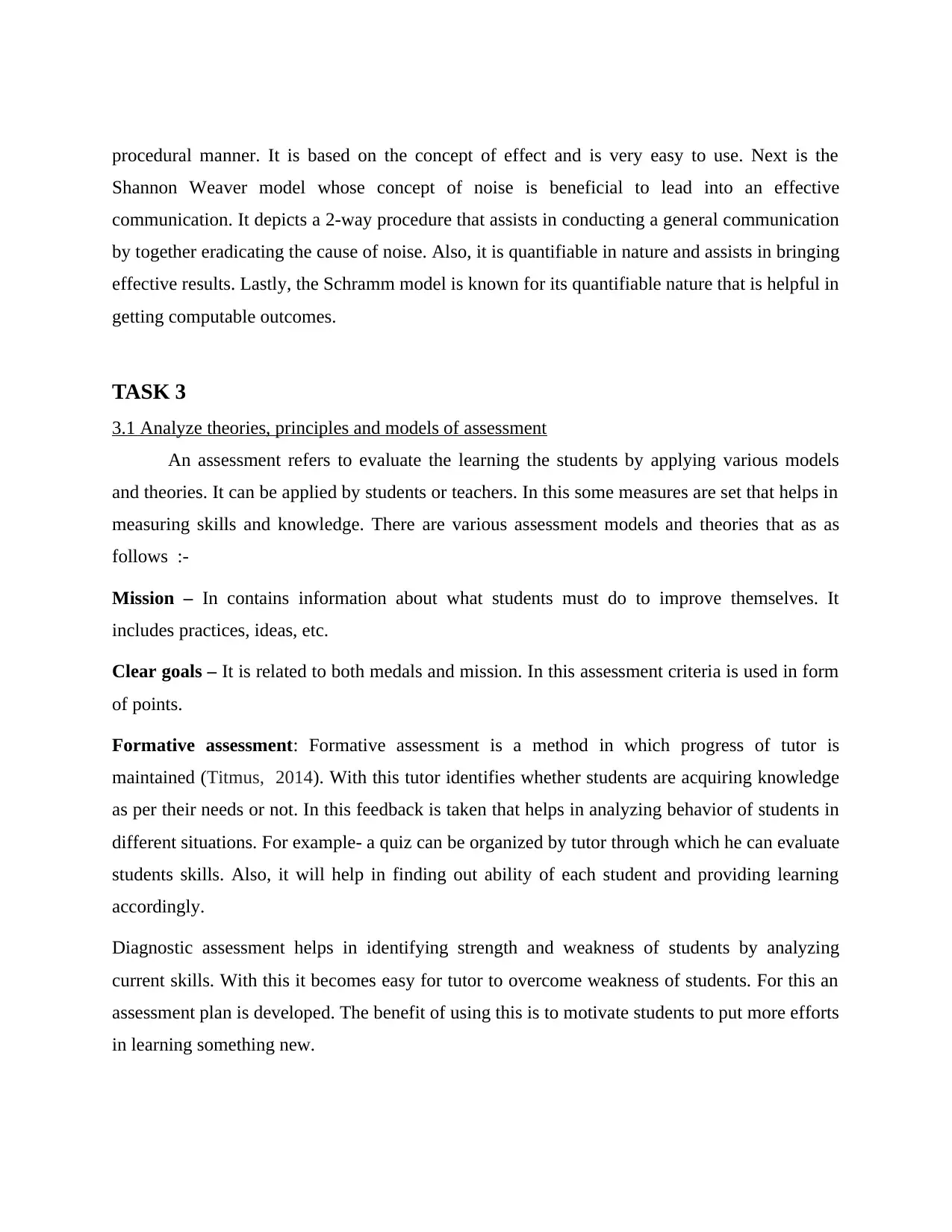
procedural manner. It is based on the concept of effect and is very easy to use. Next is the
Shannon Weaver model whose concept of noise is beneficial to lead into an effective
communication. It depicts a 2-way procedure that assists in conducting a general communication
by together eradicating the cause of noise. Also, it is quantifiable in nature and assists in bringing
effective results. Lastly, the Schramm model is known for its quantifiable nature that is helpful in
getting computable outcomes.
TASK 3
3.1 Analyze theories, principles and models of assessment
An assessment refers to evaluate the learning the students by applying various models
and theories. It can be applied by students or teachers. In this some measures are set that helps in
measuring skills and knowledge. There are various assessment models and theories that as as
follows :-
Mission – In contains information about what students must do to improve themselves. It
includes practices, ideas, etc.
Clear goals – It is related to both medals and mission. In this assessment criteria is used in form
of points.
Formative assessment: Formative assessment is a method in which progress of tutor is
maintained (Titmus, 2014). With this tutor identifies whether students are acquiring knowledge
as per their needs or not. In this feedback is taken that helps in analyzing behavior of students in
different situations. For example- a quiz can be organized by tutor through which he can evaluate
students skills. Also, it will help in finding out ability of each student and providing learning
accordingly.
Diagnostic assessment helps in identifying strength and weakness of students by analyzing
current skills. With this it becomes easy for tutor to overcome weakness of students. For this an
assessment plan is developed. The benefit of using this is to motivate students to put more efforts
in learning something new.
Shannon Weaver model whose concept of noise is beneficial to lead into an effective
communication. It depicts a 2-way procedure that assists in conducting a general communication
by together eradicating the cause of noise. Also, it is quantifiable in nature and assists in bringing
effective results. Lastly, the Schramm model is known for its quantifiable nature that is helpful in
getting computable outcomes.
TASK 3
3.1 Analyze theories, principles and models of assessment
An assessment refers to evaluate the learning the students by applying various models
and theories. It can be applied by students or teachers. In this some measures are set that helps in
measuring skills and knowledge. There are various assessment models and theories that as as
follows :-
Mission – In contains information about what students must do to improve themselves. It
includes practices, ideas, etc.
Clear goals – It is related to both medals and mission. In this assessment criteria is used in form
of points.
Formative assessment: Formative assessment is a method in which progress of tutor is
maintained (Titmus, 2014). With this tutor identifies whether students are acquiring knowledge
as per their needs or not. In this feedback is taken that helps in analyzing behavior of students in
different situations. For example- a quiz can be organized by tutor through which he can evaluate
students skills. Also, it will help in finding out ability of each student and providing learning
accordingly.
Diagnostic assessment helps in identifying strength and weakness of students by analyzing
current skills. With this it becomes easy for tutor to overcome weakness of students. For this an
assessment plan is developed. The benefit of using this is to motivate students to put more efforts
in learning something new.
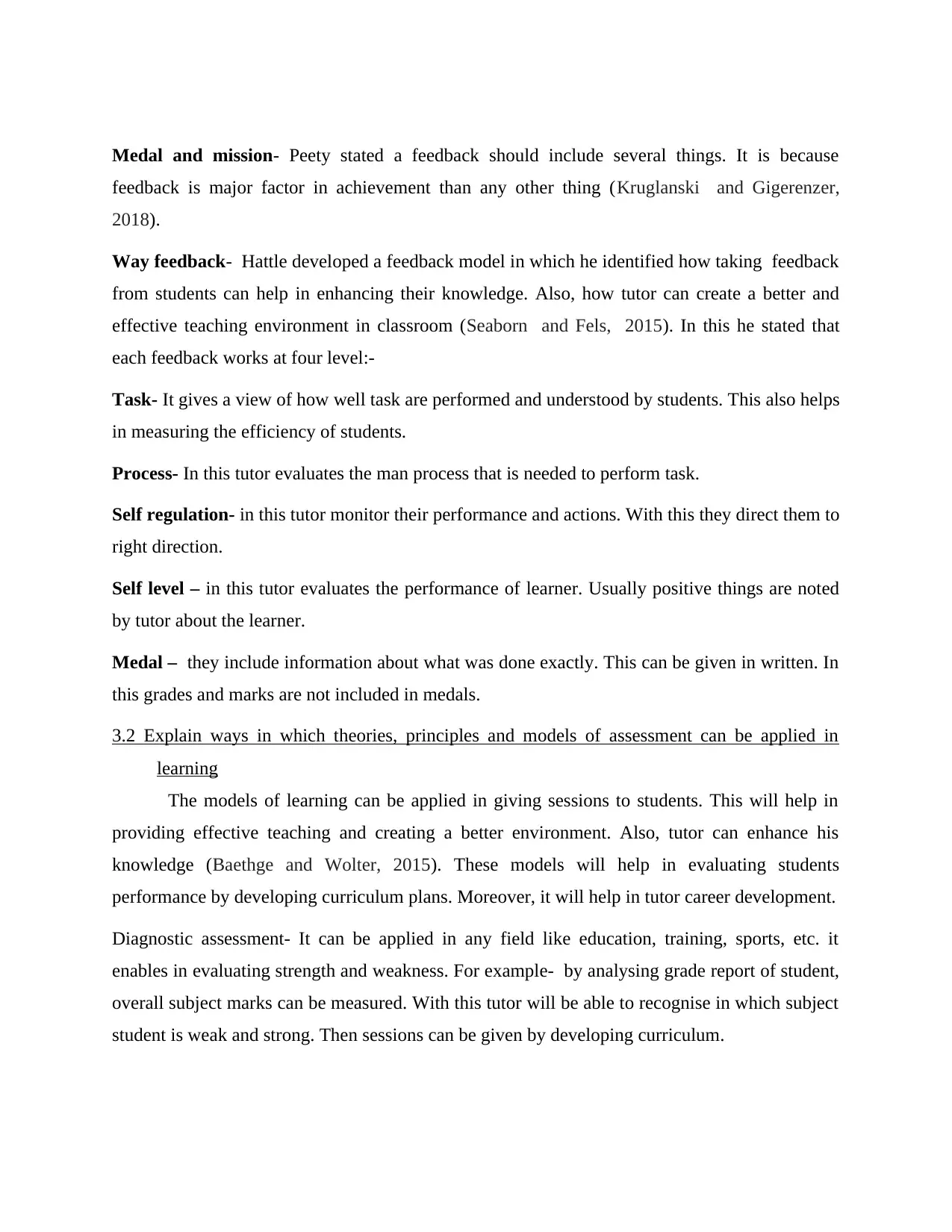
Medal and mission- Peety stated a feedback should include several things. It is because
feedback is major factor in achievement than any other thing (Kruglanski and Gigerenzer,
2018).
Way feedback- Hattle developed a feedback model in which he identified how taking feedback
from students can help in enhancing their knowledge. Also, how tutor can create a better and
effective teaching environment in classroom (Seaborn and Fels, 2015). In this he stated that
each feedback works at four level:-
Task- It gives a view of how well task are performed and understood by students. This also helps
in measuring the efficiency of students.
Process- In this tutor evaluates the man process that is needed to perform task.
Self regulation- in this tutor monitor their performance and actions. With this they direct them to
right direction.
Self level – in this tutor evaluates the performance of learner. Usually positive things are noted
by tutor about the learner.
Medal – they include information about what was done exactly. This can be given in written. In
this grades and marks are not included in medals.
3.2 Explain ways in which theories, principles and models of assessment can be applied in
learning
The models of learning can be applied in giving sessions to students. This will help in
providing effective teaching and creating a better environment. Also, tutor can enhance his
knowledge (Baethge and Wolter, 2015). These models will help in evaluating students
performance by developing curriculum plans. Moreover, it will help in tutor career development.
Diagnostic assessment- It can be applied in any field like education, training, sports, etc. it
enables in evaluating strength and weakness. For example- by analysing grade report of student,
overall subject marks can be measured. With this tutor will be able to recognise in which subject
student is weak and strong. Then sessions can be given by developing curriculum.
feedback is major factor in achievement than any other thing (Kruglanski and Gigerenzer,
2018).
Way feedback- Hattle developed a feedback model in which he identified how taking feedback
from students can help in enhancing their knowledge. Also, how tutor can create a better and
effective teaching environment in classroom (Seaborn and Fels, 2015). In this he stated that
each feedback works at four level:-
Task- It gives a view of how well task are performed and understood by students. This also helps
in measuring the efficiency of students.
Process- In this tutor evaluates the man process that is needed to perform task.
Self regulation- in this tutor monitor their performance and actions. With this they direct them to
right direction.
Self level – in this tutor evaluates the performance of learner. Usually positive things are noted
by tutor about the learner.
Medal – they include information about what was done exactly. This can be given in written. In
this grades and marks are not included in medals.
3.2 Explain ways in which theories, principles and models of assessment can be applied in
learning
The models of learning can be applied in giving sessions to students. This will help in
providing effective teaching and creating a better environment. Also, tutor can enhance his
knowledge (Baethge and Wolter, 2015). These models will help in evaluating students
performance by developing curriculum plans. Moreover, it will help in tutor career development.
Diagnostic assessment- It can be applied in any field like education, training, sports, etc. it
enables in evaluating strength and weakness. For example- by analysing grade report of student,
overall subject marks can be measured. With this tutor will be able to recognise in which subject
student is weak and strong. Then sessions can be given by developing curriculum.
⊘ This is a preview!⊘
Do you want full access?
Subscribe today to unlock all pages.

Trusted by 1+ million students worldwide
1 out of 22
Related Documents
Your All-in-One AI-Powered Toolkit for Academic Success.
+13062052269
info@desklib.com
Available 24*7 on WhatsApp / Email
![[object Object]](/_next/static/media/star-bottom.7253800d.svg)
Unlock your academic potential
Copyright © 2020–2025 A2Z Services. All Rights Reserved. Developed and managed by ZUCOL.


